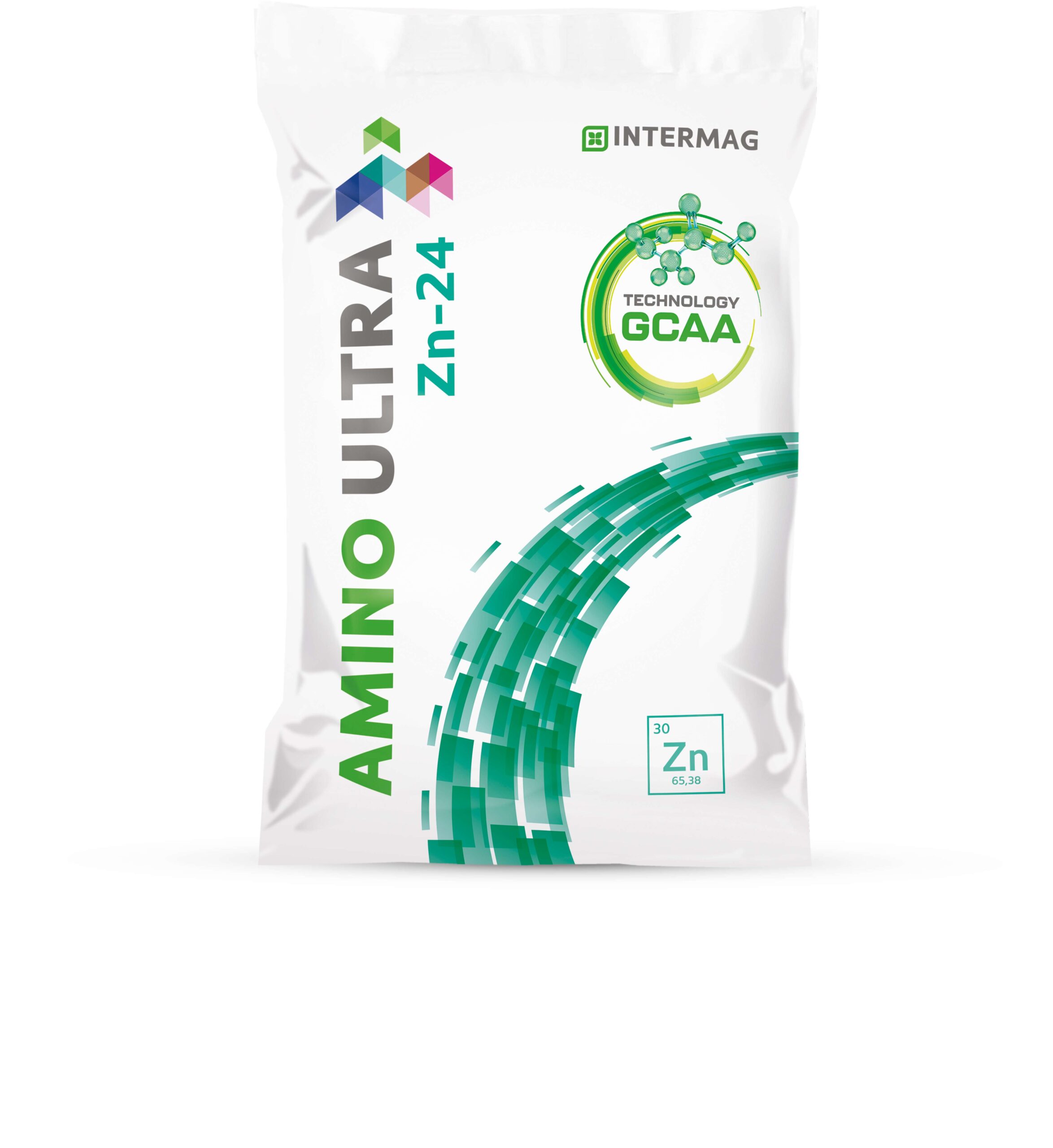Zinc (Zn) fertilizer, complexed with the amino acid glycine. With innovative Horticultural, ornamental plants:.
Amino Ultra Zn-24
AMINO ULTRA Zn-24 is a product of INTERMAG’s specialized know-how, incorporating the innovative GCAA technology, through which all zinc ions (Zn) are complexed with the amino acid glycine (zinc glycine). Thanks to this innovative complex, zinc is absorbed, transported and assimilated by plants much faster than from other, conventional, zinc foliar fertilizers. It is recommended for foliar applications in all crops and especially the most demanding in zinc, such as cereals, corn, apples, stone fruits, etc. Effectively prevents the occurrence and cures zinc deficiency in plants. It is especially recommended for weakened plants, in need of recovery or for plants with delayed growth. Its application is also particularly useful in soils with limited zinc availability for plants (e.g. in soils with a pH >7.5).
With AMINO ULTRA Zn-24, you achieve:
Immediate and effective delivery of zinc to plants.
High nutrient concentration – low application rate.
Efficiency and safety – even in difficult crop conditions.
With innovative GCAA technology
Zinc (Zn), complexed with glycine, water soluble: 24.0% w/w (240 g/Kg)
Dosage per application:
| Extensive crops | Deciduous with 20–60 gr/acre. |
| Tree crops (Apple, Stone fruit, Pine, Citrus, Olive), Vine, Avocado, Strawberry/ Small fruit crops: | Deciduous with 30–60 gr/acre. |
| Horticultural, ornamental plants: | Deciduous with 10–60 gr/acre. |
Time of application:
It can be applied throughout the crop cycle depending on plant nutrient needs, however, the most critical periods-stages per crop group are listed below:
Apples (Apple, Pear, Quince): ¨Green top, ¨Pink/white top until the beginning of flowering, ¨When the fruits reach 30-50% of their standard size. ¨Postharvest (before the leaves lose their green color).
Stone fruit (Peach, Apricot, Plum, Cherry, Cherry): ¨Pink bud, ¨Calyx fall – fruit development, ¨When the fruits reach 30-50% of their standard size, ¨Post-harvest (before the leaves lose their green color their).
Citrus fruits: ¨Appearance of the first new leaves, ¨Beginning of flowering, ¨Development of the fruit: 2 applications, with an interval of 10-14 days.
Olive: ¨Appearance of the first new leaves, ¨From the appearance of inflorescence stems to the beginning of flowering, ¨Setting fruit – fruit the size of a slag, ¨Post-harvest.
Vine: ¨Commencement of new leaves and shoots, ¨Appearance of inflorescence, ¨Development of the fruit – until the rails reach the size of a pea, ¨Post-harvest.
Strawberry/ Small fruit crops: ¨Initiation of leaf/crown growth, ¨Inflorescence emergence, ¨Fruit development, ¨Postharvest: 1–2 applications at 10–14 day intervals.
Horticulture: Fruits (Solanaceae, Cucurbitaceae): ¨Start of shoot/leaf growth, ¨Development of the first flowering buds, ¨Development of fruits: 2-3 applications with an interval of 7-21 days.
Vegetables: Crocus (Broccoli, Cauliflower, etc.): ¨Development of leaves: 1-2 applications, with an interval of 7-14 days, ¨Development of the parts intended for harvest: 1-2 applications, with an interval of 7-21 days .
Vegetables: Bulbous, Rhizomatous (Onion, Carrot, etc.): ¨Beginning of leaf growth, ¨Beginning of growth of the storage organs, ¨When the storage organs reach 40–50% of their standard size.
Potato: ¨Beginning of leaf and shoot development, ¨Beginning of tuberization ¨Beginning of tuber growth, ¨When the tubers reach 50% of their final size.
Winter cereals, Maize, Rice: ¨When 3-6 leaves have unfolded, ¨Development of leaves – adelphoma, ¨Elongation of the stem – until the appearance of the inflorescence.
Industrial plants (Rapeseed, Cotton, Sunflower): ¨Beginning of leaf growth, ¨Development of the main stem and side shoots, ¨Beginning of flower bud/comb/head development, ¨Beginning of pod/nut development.
Soy and other legumes (legumes or vegetables): ¨Development of the first true leaves, ¨Beginning of flower bud development, ¨Beginning of pod and seed development.
Ornamental plant nurseries: ¨During the period of young seedling production: 2–3 applications every 7–21 days.





